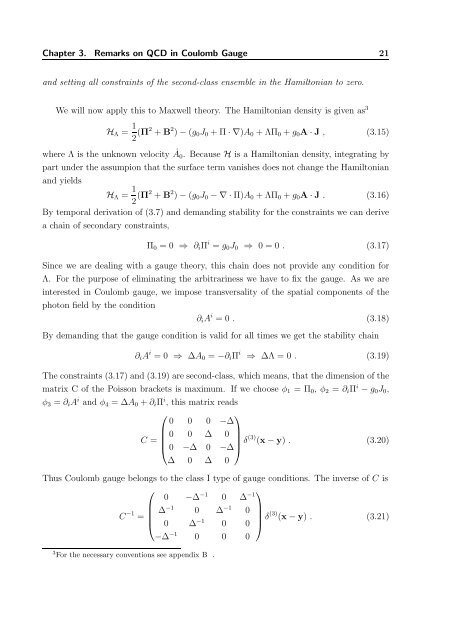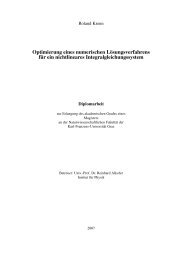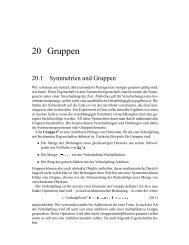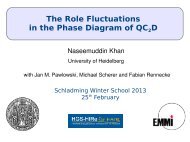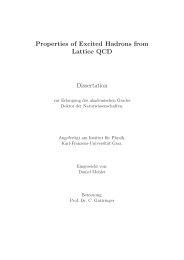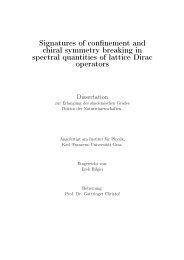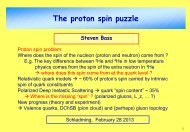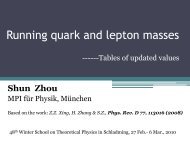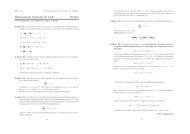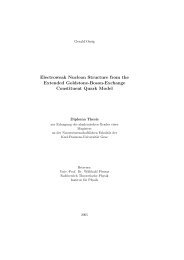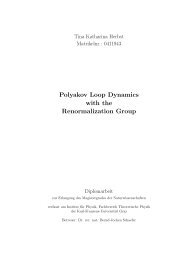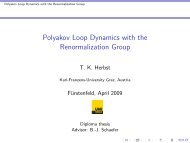The QCD Quark Propagator in Coulomb Gauge and - Institut für Physik
The QCD Quark Propagator in Coulomb Gauge and - Institut für Physik
The QCD Quark Propagator in Coulomb Gauge and - Institut für Physik
Create successful ePaper yourself
Turn your PDF publications into a flip-book with our unique Google optimized e-Paper software.
Chapter 3. Remarks on <strong>QCD</strong> <strong>in</strong> <strong>Coulomb</strong> <strong>Gauge</strong> 21<br />
<strong>and</strong> sett<strong>in</strong>g all constra<strong>in</strong>ts of the second-class ensemble <strong>in</strong> the Hamiltonian to zero.<br />
We will now apply this to Maxwell theory. <strong>The</strong> Hamiltonian density is given as 3<br />
H Λ = 1 2 (Π2 + B 2 ) − (g 0 J 0 + Π · ∇)A 0 + ΛΠ 0 + g 0 A · J , (3.15)<br />
where Λ is the unknown velocity Ȧ0. Because H is a Hamiltonian density, <strong>in</strong>tegrat<strong>in</strong>g by<br />
part under the assumpion that the surface term vanishes does not change the Hamiltonian<br />
<strong>and</strong> yields<br />
H Λ = 1 2 (Π2 + B 2 ) − (g 0 J 0 − ∇ · Π)A 0 + ΛΠ 0 + g 0 A · J . (3.16)<br />
By temporal derivation of (3.7) <strong>and</strong> dem<strong>and</strong><strong>in</strong>g stability for the constra<strong>in</strong>ts we can derive<br />
a cha<strong>in</strong> of secondary constra<strong>in</strong>ts,<br />
Π 0 = 0 ⇒ ∂ i Π i = g 0 J 0 ⇒ 0 = 0 . (3.17)<br />
S<strong>in</strong>ce we are deal<strong>in</strong>g with a gauge theory, this cha<strong>in</strong> does not provide any condition for<br />
Λ. For the purpose of elim<strong>in</strong>at<strong>in</strong>g the arbitrar<strong>in</strong>ess we have to fix the gauge. As we are<br />
<strong>in</strong>terested <strong>in</strong> <strong>Coulomb</strong> gauge, we impose transversality of the spatial components of the<br />
photon field by the condition<br />
∂ i A i = 0 . (3.18)<br />
By dem<strong>and</strong><strong>in</strong>g that the gauge condition is valid for all times we get the stability cha<strong>in</strong><br />
∂ i A i = 0 ⇒ ∆A 0 = −∂ i Π i ⇒ ∆Λ = 0 . (3.19)<br />
<strong>The</strong> constra<strong>in</strong>ts (3.17) <strong>and</strong> (3.19) are second-class, which means, that the dimension of the<br />
matrix C of the Poisson brackets is maximum. If we choose φ 1 = Π 0 , φ 2 = ∂ i Π i − g 0 J 0 ,<br />
φ 3 = ∂ i A i <strong>and</strong> φ 4 = ∆A 0 + ∂ i Π i , this matrix reads<br />
⎛<br />
⎞<br />
0 0 0 −∆<br />
0 0 ∆ 0<br />
C = ⎜<br />
⎟<br />
⎝ 0 −∆ 0 −∆⎠ δ(3) (x − y) . (3.20)<br />
∆ 0 ∆ 0<br />
Thus <strong>Coulomb</strong> gauge belongs to the class I type of gauge conditions. <strong>The</strong> <strong>in</strong>verse of C is<br />
⎛<br />
⎞<br />
0 −∆ −1 0 ∆ −1<br />
C −1 ∆ −1 0 ∆ −1 0<br />
= ⎜<br />
⎟<br />
⎝ 0 ∆ −1 0 0 ⎠ δ(3) (x − y) . (3.21)<br />
−∆ −1 0 0 0<br />
3 For the necessary conventions see appendix B .


